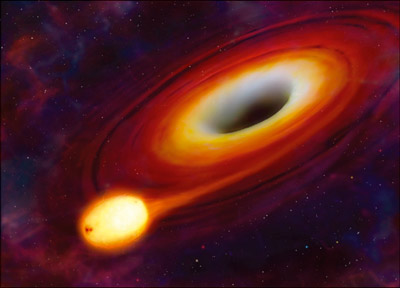
Image credit: University of Warwick/Mark A Garlick.
Follow-up observations of an apparently normal gamma-ray burst (GRB) detected by NASA’s Swift satellite have identified the event as a star being ripped apart by a massive black hole in a distant galaxy. Two articles in Science report on the observational investigations and the physical interpretation of this rare sight.
On 28 March 2011 at 12.57 UT, an outburst of gamma rays was detected by the Burst Alert Telescope (BAT) on the Swift satellite. Called GRB 110328A, the GRB looked like one of the hundreds that Swift has already detected since its launch in November 2004 (CERN Courier December 2005 p20). As always, the satellite pointed its narrow-field optical and X-ray telescopes towards the transient source to observe the decline of the GRB afterglow within minutes to hours (CERN Courier October 2005 p11, CERN Courier May 2007 p11). This time, however, the source remained bright and highly variable, with repeated outbursts triggering the BAT three more times in 48 hours. As the days passed with no major decline in X-rays, it became obvious that this source was not a usual GRB and it was thus dubbed Sw 1644+57.
Astronomers had begun ground-based follow-up observations soon after the burst. In one of the reports in Science, Andrew Levan of the University of Warwick and collaborators tell the detective story involved in the identification of the event. While the Gemini-North Telescope in Hawaii had poor weather conditions two hours after the burst, 11 hours later the Nordic Optical Telescope on La Palma in the Canary Islands detected a faint galaxy at the position of the burst. Subsequent spectroscopic observations determined a redshift of 0.35, indicating that the source is nearly four thousand million light-years away. The unusual characteristics of the event awoke the curiosity of the Hubble Space Telescope, which was able to pinpoint it to the very centre of the remote galaxy – a finding confirmed in radio observations by the Very Large Baseline Array.
Could the object be a quasar? Archival data show no sign of nuclear activity in this relatively small galaxy and, furthermore, the luminosity released by the event exceeds by a factor of 100 the flares from the most powerful active galactic nuclei. So what else can release the energy equivalent to 10% of the rest mass of the entire Sun in less than two weeks? A possibility is the disruption and swallowing of a star venturing too close to the event horizon of a black hole. At least this is the conclusion reached by Joshua Bloom of the University of California, Berkeley, and colleagues, although they admit that Sw 1644+57 initially displayed none of the theoretically anticipated– nor observed – characteristics of such an event.
The poor observational and theoretical knowledge of tidal-disruption flares is a consequence of their rarity: they should occur only about 1 to 10 times every 100,000 years in a given galaxy (CERN Courier April 2004 p12). Because such an event would be so unlikely, theorists did not consider that a putative jet emitted from the black hole devouring a star would point right towards Earth. As unlikely as it seems, J Bloom and collaborators found strong evidence that this had to be the case for Sw 1644+57 because the observed luminosity would be too high for the inferred mass of the black hole – below 10 million solar masses – if it were not enhanced by relativistic beaming in a jet aligned with the line-of-sight. So everything points to the disruption of a star that has swiftly turned a dormant black hole into a luminous blazar (see, for example, CERN Courier June 2006 p14). The source was restless for the three following weeks, and so were the scientists who eagerly had to write the two papers and submit them jointly to Science on 18 April 2011!








